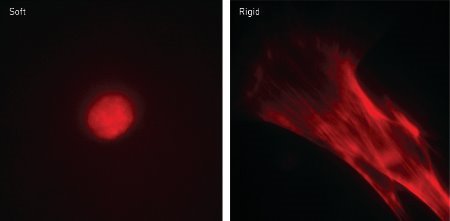May 2, 2014 Research Highlight Biology
Stem cells may prefer soft surfaces
Soft substrates may promote the production of induced pluripotent stem cells
 Figure 1: Fluorescence microscopy image of cells cultured on soft (left) and rigid (right) substrates. Actin filaments (red) in these cells display dramatic differences in number and organization depending on substrate elasticity. Reproduced, with permission, from Ref. 1 © 2013 The Society for Biotechnology, Japan
Figure 1: Fluorescence microscopy image of cells cultured on soft (left) and rigid (right) substrates. Actin filaments (red) in these cells display dramatic differences in number and organization depending on substrate elasticity. Reproduced, with permission, from Ref. 1 © 2013 The Society for Biotechnology, Japan
Converting adult cells into stem cells that can develop into other types of specialized cells is one of the most active areas of medical research, holding great promise for the treatment of disease and repair of damaged tissues. The techniques available for reprogramming adult cells into stem cells, however, remain imperfect and inefficient. In research that could help improve reprogramming efficiency, Sayaka Higuchi and colleagues from the RIKEN Quantitative Biology Center have now found that culturing cells on soft or elastic substrates enhances expression of some of the markers of stem cell reprogramming1.
Motivated by previous observations that culturing cells on soft surfaces can affect their ability to multiply and renew, Higuchi and her team set out to examine whether the same principle might be applicable to enhancing the efficiency of producing induced pluripotent stem (iPS) cells—a type of stem cell that is reprogrammed from mature adult fibroblast cells using methods such as the introduction of genetic factors.
The researchers investigated the effect of culturing mouse and human fibroblasts treated with these factors on a range of gel substrates with different compositions and elasticities. They found that genes associated with reprogramming into stem cells were more active in the cells cultured on some of the soft surfaces than in the cells cultured on conventional rigid plastic dishes. They also found that changes in substrate elasticity significantly altered the amount and distribution of actin fibers, suggesting that the actin protein may be involved in mediating the effect of the substrate on the reprogramming process (Fig. 1).
Although the team did not proceed to the actual generation of viable stem cells, the results provide some promising avenues for further research. “It is likely that soft substrates promote only the initiation of the reprogramming process,” explains Higuchi. “Even so, the results could lead to more effective and reproducible ways to produce pluripotent stem cells.”
Another possibility of particular interest to Higuchi follows from her team’s observations that the combination of chemical treatment with substrate manipulation could potentially form the basis for a full reprogramming method that does not involve gene transfer—a process that involves retroviral infection of mature cells with pluripotency factors. “Gene transfer is still the main method for full reprogramming of iPS cells,” says Higuchi, “but if we can find a method for producing pluripotent stem cells that avoids this process, the cells may be much safer for medical use.”
References
- 1. Higuchi, S., Watanabe, T. M., Kawauchi, K., Ichimura, T. & Fujita, H. Culturing of mouse and human cells on soft substrates promote the expression of stem cell markers. Journal of Bioscience and Bioengineering 6, 749–755 (2014). doi: 10.1016/j.jbiosc.2013.11.011
